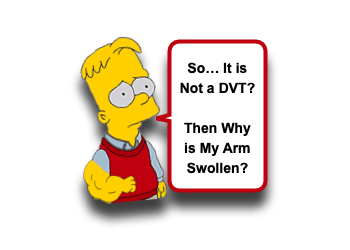Thoracic Outlet Syndrome in Children

Keeping a broad differential list is imperative to our task of being medical detectives. Avoiding premature closure of that Ddx list is also imperative. Often, we proceed to evaluate a condition with the idea of eliminating the most concerning and/or most common causes; however, as we have learned from the Ped EM Morsels, it is our vigilance that helps us to find the uncommon, yet still threatening! A swollen arm is most likely due to an injury (ex, supracondylar fracture, lateral condyle fracture, wrist fracture) or an infection (ex, abscess). If we are vigilant, we will also consider Deep Venous Thrombosis. What else should we keep on that Ddx list though? Perhaps something our dear friend Dr. Simone Lawson brought to my attention this week. Let us take a minute to review Thoracic Outlet Syndrome in Children:
Thoracic Outlet Syndrome: Basics
- Thoracic Outlet Syndrome is a collection of disorders related to compression of the NeuroVascular structures that pass between the clavicle and the scalene muscles. [Vu, 2014; Arthur, 2008]
- Brachial Plexus
- Subclavian Artery
- Subclavian Vein
- Cervical ribs, Congenital Bands, and Fused 1st Ribs further narrow this space and increase risk for thoracic outlet syndrome. [Vu, 2014; Arthur, 2008]
- Cervical or anomalous 1st ribs are present in ~40% of pediatric cases.
- Adults vs Children [Vu, 2014; Arthur, 2008]
- Adults:
- Well recognized and reported.
- 90% of cases are neurologic – paresthesias, pain, weakness.
- More likely to experience hyperextension trauma and overuse injuries.
- Children:
- Not as well recognized…. mostly case reports. [Arthur, 2008]
- Have higher percentage of cases (~56%) due to vascular compression. [Arthur, 2008]
- Young athletes may experience hyper-abduction of affected limb as well as some unique sports-related overuse injuries (ex, pitching). [Arthur, 2008]
- Adults:
Thoracic Outlet Syndrome: Signs
- Symptoms are dependent upon the structure being compressed.
- Neurogenic Thoracic Outlet Syndrome [Arthur, 2008]
- Often with vague complaints.
- Pain radiating down the arm
- Numbness / paresthesias with Abduction
- Decreased strength.
- Vascular Thoracic Outlet Syndrome [Arthur, 2008]
- Aterial (least common)
- Color change in the arm / hand with Activity
- Loss of pulse with abduction
- Painless pulsating mass (aneurysmal changes)
- May also present with neurologic complaints (numbness, tingling).
- Venous
- Edema
- May present with effort dependent thrombosis with acute swelling, pain, and discoloration following heavy physical activity (Paget-Schroetter Syndrome).
- Aterial (least common)
- Clinical signs: [Vu, 2014]
- Clinical signs may not be reliable… but are still good to look for.
- Adson’s Test (see for example)
- Arm is abducted 30 degrees and shoulder is maximally extended while palpating the radial pulse.
- Then patient extends and turns head toward symptomatic shoulder. Taking a deep breath will further reduce the space.
- Positive if there is a marked decrease, or disappearance, of the radial pulse. Good to compare to other side.
- Roos Elevated Arm Stress Test (see for example)
- Have both arms in the 90° abduction and external rotation.
- Patient opens and closes both hands slowly over 3 minutes.
- Positive if:
- Increased neck/shoulder pain
- Paresthesias of fingers/forearm
- Change in color
- Inability to complete test due to weakness
- Wright Test (see for example)
- While palpating the radial pulse, abduct and externally rotate the shoulder. Hold in position for 1 min.
- Positive test if pulse is diminished or patient develops symptoms.
Thoracic Outlet Syndrome: Management
- Ultrasound is a good screening test. [Arthur, 2008]
- Thrombosis? May be related to structural compression, so further imaging is needed.
- Can demonstrate arterial or venous impingement.
- May show aneurysmal changes for vasculature.
- Can be performed with provocative positioning (abduction) of the arm.
- Chest X-Ray is reasonable to evaluate for congenital rib abnormalities. [Vu, 2014; Arthur, 2008]
- MRI of Neck is preferred screen when neurogenic thoracic outlet syndrome is suspected. [Arthur, 2008]
- No screening test is perfect, so if clinical suspicion is high, may need to proceed with additional imaging. [Arthur, 2008]
- Therapies: [Arthur, 2008]
- Often managed conservatively for the first 6-12 months. [Vu, 2014]
- Alleviation of compression is required.
- 1st rib resection
- Scalenectomy
- Anticoagulation of thrombosis.
Moral of the Morsel
- It is not always a DVT. A swollen arm may be related to Thoracic Outlet Syndrome.
- It may be a DVT… but why is there a DVT? Finding a DVT does not alleviate concern.
- Don’t be eager to blame “muscle strain.” Upper extremity symptoms that occur with active abduction or strenuous use may be due to Thoracic Outlet Syndrome.

